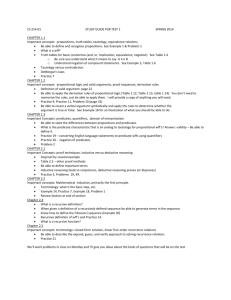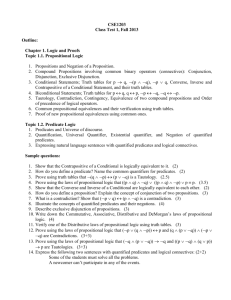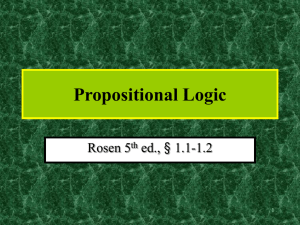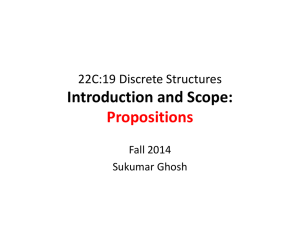Chapter 1: The Foundations: Logic and Proofs
advertisement
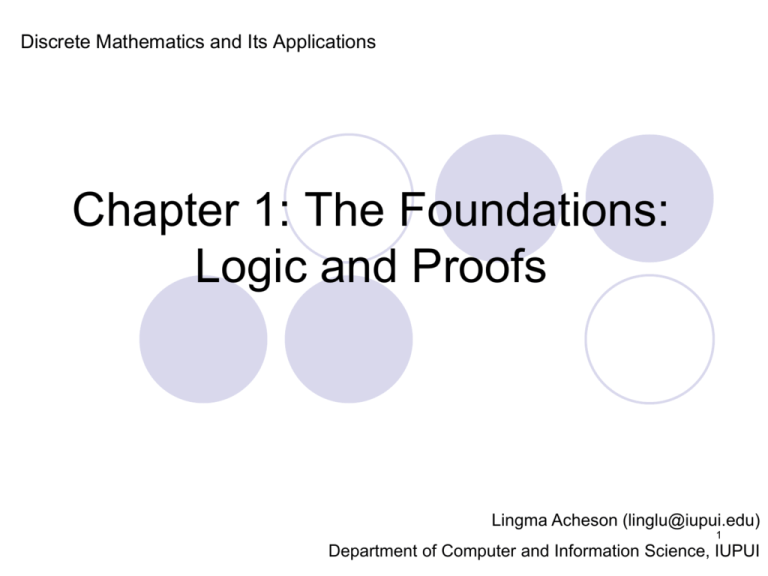
Discrete Mathematics and Its Applications Chapter 1: The Foundations: Logic and Proofs Lingma Acheson (linglu@iupui.edu) 1 Department of Computer and Information Science, IUPUI 1.1 Propositional Logic Introduction A proposition is a declarative sentence (a sentence that declares a fact) that is either true or false, but not both. Are the following sentences propositions? Toronto is the capital of Canada. (Yes) Read this carefully. (No) 1+2=3 (Yes) x+1=2 (No) What time is it? (No) 2 1.1 Propositional Logic Propositional Logic – the area of logic that deals with propositions Propositional Variables – variables that represent propositions: p, q, r, s E.g. Proposition p – “Today is Friday.” Truth values – T, F 3 1.1 Propositional Logic DEFINITION 1 Let p be a proposition. The negation of p, denoted by ¬p, is the statement “It is not the case that p.” The proposition ¬p is read “not p.” The truth value of the negation of p, ¬p is the opposite of the truth value of p. Examples Find the negation of the proposition “Today is Friday.” and express this in simple English. Solution: The negation is “It is not the case that today is Friday.” In simple English, “Today is not Friday.” or “It is not Friday today.” Find the negation of the proposition “At least 10 inches of rain fell today in Miami.” and express this in simple English. Solution: The negation is “It is not the case that at least 10 inches of rain fell today in Miami.” In simple English, “Less than 10 inches of rain fell today in Miami.” 4 1.1 Propositional Logic Note: Always assume fixed times, fixed places, and particular people unless otherwise noted. Truth table: The Truth Table for the Negation of a Proposition. p ¬p T F F T Logical operators are used to form new propositions from two or more existing propositions. The logical operators are also called connectives. 5 1.1 Propositional Logic DEFINITION 2 Let p and q be propositions. The conjunction of p and q, denoted by p Λ q, is the proposition “p and q”. The conjunction p Λ q is true when both p and q are true and is false otherwise. Examples Find the conjunction of the propositions p and q where p is the proposition “Today is Friday.” and q is the proposition “It is raining today.”, and the truth value of the conjunction. Solution: The conjunction is the proposition “Today is Friday and it is raining today.” The proposition is true on rainy Fridays. 6 1.1 Propositional Logic DEFINITION 3 Let p and q be propositions. The disjunction of p and q, denoted by p ν q, is the proposition “p or q”. The conjunction p ν q is false when both p and q are false and is true otherwise. Note: inclusive or : The disjunction is true when at least one of the two propositions is true. E.g. “Students who have taken calculus or computer science can take this class.” – those who take one or both classes. exclusive or : The disjunction is true only when one of the proposition is true. E.g. “Students who have taken calculus or computer science, but not both, can take this class.” – only those who take one of them. Definition 3 uses inclusive or. 7 1.1 Propositional Logic DEFINITION 4 Let p and q be propositions. The exclusive or of p and q, denoted by p q, is the proposition that is true when exactly one of p and q is true and is false otherwise. The Truth Table for the Conjunction of Two Propositions. p T T F F q pΛq T F T F T F F F The Truth Table for the Disjunction of Two Propositions. p T T F F The Truth Table for the Exclusive Or (XOR) of Two Propositions. q pνq p q T F T F T T T F T T F F T F T F p q F T T F 8 1.1 Propositional Logic Conditional Statements DEFINITION 5 Let p and q be propositions. The conditional statement p → q, is the proposition “if p, then q.” The conditional statement is false when p is true and q is false, and true otherwise. In the conditional statement p → q, p is called the hypothesis (or antecedent or premise) and q is called the conclusion (or consequence). A conditional statement is also called an implication. Example: “If I am elected, then I will lower taxes.” p→q implication: elected, lower taxes. not elected, lower taxes. not elected, not lower taxes. elected, not lower taxes. T F F T T T F F |T |T |T |F 9 1.1 Propositional Logic Example: Let p be the statement “Maria learns discrete mathematics.” and q the statement “Maria will find a good job.” Express the statement p → q as a statement in English. Solution: Any of the following - “If Maria learns discrete mathematics, then she will find a good job. “Maria will find a good job when she learns discrete mathematics.” “For Maria to get a good job, it is sufficient for her to learn discrete mathematics.” “Maria will find a good job unless she does not learn discrete mathematics.” 10 1.1 Propositional Logic Other conditional statements: Converse of p → q : q → p Contrapositive of p → q : ¬ q → ¬ p Inverse of p → q : ¬ p → ¬ q 11 1.1 Propositional Logic DEFINITION 6 Let p and q be propositions. The biconditional statement p ↔ q is the proposition “p if and only if q.” The biconditional statement p ↔ q is true when p and q have the same truth values, and is false otherwise. Biconditional statements are also called bi-implications. p ↔ q has the same truth value as (p → q) Λ (q → p) “if and only if” can be expressed by “iff” Example: Let p be the statement “You can take the flight” and let q be the statement “You buy a ticket.” Then p ↔ q is the statement “You can take the flight if and only if you buy a ticket.” Implication: If you buy a ticket you can take the flight. If you don’t buy a ticket you cannot take the flight. 12 1.1 Propositional Logic The Truth Table for the Biconditional p ↔ q. p T T F F q T F T F p↔ q T F F T 13 1.1 Propositional Logic Truth Tables of Compound Propositions We can use connectives to build up complicated compound propositions involving any number of propositional variables, then use truth tables to determine the truth value of these compound propositions. Example: Construct the truth table of the compound proposition (p ν ¬q) → (p Λ q). The Truth Table of (p ν ¬q) → (p Λ q). p q ¬q p ν ¬q pΛq (p ν ¬q) → (p Λ q) T T F F T F T F F T F T T T F T T F F F T F T F 14 1.1 Propositional Logic Precedence of Logical Operators We can use parentheses to specify the order in which logical operators in a compound proposition are to be applied. To reduce the number of parentheses, the precedence order is defined for logical operators. Precedence of Logical Operators. E.g. ¬p Λ q = (¬p ) Λ q Operator Precedence p Λ q ν r = (p Λ q ) ν r ¬ 1 p ν q Λ r = p ν (q Λ r) Λ ν 2 3 → ↔ 4 5 15 1.1 Propositional Logic Translating English Sentences English (and every other human language) is often ambiguous. Translating sentences into compound statements removes the ambiguity. Example: How can this English sentence be translated into a logical expression? “You cannot ride the roller coaster if you are under 4 feet tall unless you are older than 16 years old.” Solution: Let q, r, and s represent “You can ride the roller coaster,” “You are under 4 feet tall,” and “You are older than 16 years old.” The sentence can be translated into: (r Λ ¬ s) → ¬q. 16 1.1 Propositional Logic Example: How can this English sentence be translated into a logical expression? “You can access the Internet from campus only if you are a computer science major or you are not a freshman.” Solution: Let a, c, and f represent “You can access the Internet from campus,” “You are a computer science major,” and “You are a freshman.” The sentence can be translated into: a → (c ν ¬f). 17 1.1 Propositional Logic Logic and Bit Operations Computers represent information using bits. A bit is a symbol with two possible values, 0 and 1. By convention, 1 represents T (true) and 0 represents F (false). A variable is called a Boolean variable if its value is either true or false. Bit operation – replace true by 1 and false by 0 in logical operations. Table for the Bit Operators OR, AND, and XOR. x y xνy x Λy 0 0 1 1 0 1 0 1 0 1 1 1 0 0 0 1 x 0 1 1 0 y 18 1.1 Propositional Logic DEFINITION 7 A bit string is a sequence of zero or more bits. The length of this string is the number of bits in the string. Example: Find the bitwise OR, bitwise AND, and bitwise XOR of the bit string 01 1011 0110 and 11 0001 1101. Solution: 01 1011 0110 11 0001 1101 ------------------11 1011 1111 bitwise OR 01 0001 0100 bitwise AND 10 1010 1011 bitwise XOR 19 1.2 Propositional Equivalences Introduction DEFINITION 1 A compound proposition that is always true, no matter what the truth values of the propositions that occurs in it, is called a tautology. A compound proposition that is always false is called a contradiction. A compound proposition that is neither a tautology or a contradiction is called a contingency. Examples of a Tautology and a Contradiction. p ¬p p ν ¬p p Λ ¬p T F F T T T F F 20 1.2 Propositional Equivalences Logical Equivalences DEFINITION 2 The compound propositions p and q are called logically equivalent if p ↔ q is a tautology. The notation p ≡ q denotes that p and q are logically equivalent. Compound propositions that have the same truth values in all possible cases are called logically equivalent. Example: Show that ¬p ν q and p → q are logically equivalent. Truth Tables for ¬p ν q and p → q . p q ¬p ¬p ν q p→q T T F F T F T F F F T T T F T T T F T T 21 1.2 Propositional Equivalences In general, 2n rows are required if a compound proposition involves n propositional variables in order to get the combination of all truth values. See page 24, 25 for more logical equivalences. 22 1.2 Propositional Equivalences Constructing New Logical Equivalences Example: Show that ¬(p → q ) and p Λ ¬q are logically equivalent. Solution: ¬(p → q ) ≡ ¬(¬p ν q) by example on slide 21 ≡ ¬(¬p) Λ ¬q by the second De Morgan law ≡ p Λ ¬q by the double negation law Example: Show that (p Λ q) → (p ν q) is a tautology. Solution: To show that this statement is a tautology, we will use logical equivalences to demonstrate that it is logically equivalent to T. (p Λ q) → (p ν q) ≡ ¬(p Λ q) ν (p ν q) by example on slide 21 ≡ (¬ p ν ¬q) ν (p ν q) by the first De Morgan law ≡ (¬ p ν p) ν (¬ q ν q) by the associative and communicative law for disjunction ≡TνT 23 ≡T Note: The above examples can also be done using truth tables.

